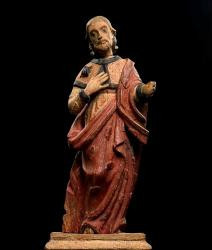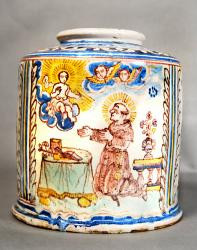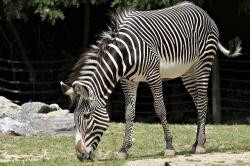Stephen Binns's collections
You Might Remember This: A Smithsonian Movie Quiz
<p class="MsoNormal">This Smithsonian quiz brings the actual world to bear on the
worlds created by filmmakers in the last century or so. The rules are simple.
The player looks at a set of museum objects from anywhere around the
Smithsonian and tries to answer a question: <em>These
Smithsonian things remind me of a movie. Can you guess which one? </em></p>
<p>Each
question is set up much like what is below. A multiple choice is in the box with the question mark. The answer is in the last box. The movie
used for the example here is <em>Casablanca. </em>You
know, the one about the fundamental things and their many applications. To take the quiz, <a href="https://learninglab.si.edu/profile/188">click
here</a>.</p>
<p><br /></p>
 Stephen Binns
Stephen Binns
5
Platonic Relationships
<p class="MsoNormal"><a href="https://www.learninglab.si.edu/collections/platonic-relationships/ypf4FN07VAGm8oeb#r/141208">Click
here</a></p>
 Stephen Binns
Stephen Binns
1
Platonic Relationships
<p class="MsoNormal">The dialogues of Plato are little dramas of ideas, starring
his late teacher Socrates, who left no writings of his own. Often we find
Socrates and his students grappling with definitions. The long dialogue <em>The Republic,</em> for example, centers on the
question <em>What is justice? </em>The
conversation sometimes begins with the relationships of various ordinary things
that can be called by the same word, such as <em>table </em>or <em>bed. </em>The
definition comes down to the “form" in which a thing “participates."</p>
<p>Your class might enjoy a brief introduction to what is called Plato's <em>theory of forms </em>or <em>theory of ideas.</em> Along the way you can match wits, not with the philosopher, but with the search engine of this website. A second part of this mini-symposium (minus the wine) looks at Plato the geometry teacher. To begin, <a href="https://learninglab.si.edu/collections/platonic-relationships-2/ukvkndxlrnavuwrj#r">click here</a>.<span></span><span></span></p>
 Stephen Binns
Stephen Binns
6
Saints by the Look of Them: Nicholas, Patrick, Stephen
<p><span class="dotdotdot"></span></p>
<p>Here are six representations of saints in the Smithsonian’s collections. Two are St. Nicholas, two<br /> are St. Patrick, two are St. Stephen. In this game, you’ll try to unite the two versions of each saint <br /> in a folder marked NICHOLAS, PATRICK, or STEPHEN. If you need hints, you will find information <br />on the saints' lives and the conventions of their depiction in art. To go to the game, <a href="http://learninglab.si.edu/collections/hint-1/yugslvwbhvjgr0dn#r/163387">click here</a>.</p>
<p> ↓ If you are an educator, click READ MORE.</p>
<p><br /></p>
<p><br /></p>
 Stephen Binns
Stephen Binns
6
Saints by the Look of Them: Gabriel, Michael, Raphael (Catholic Education)
<p>Here are six representations in the Smithsonian's collections of the Big Three of angels. Two <br />are St. Gabriel, two are St. Michael, two are St. Raphael. In this game, you’ll try to unite the two<br /> versions of each angel in a folder marked GABRIEL, MICHAEL, or RAPHAEL. If you need hints, you <br />will find information on the conventions of their depiction in art. To go to the game, <a href="https://learninglab.si.edu/collections/hint-1/4b5tx81pGnBwKmNo#r/164315">click here</a>.</p>
<p>
↓ If you are an educator, click READ MORE.</p><p><br /></p>
 Stephen Binns
Stephen Binns
6
Saints by the Look of Them: Barbara, Anne, Ursula
<p><span class="dotdotdot">Here are six representations of saints in the Smithsonian’s collections. Two are St. Barbara, two <br />are St. Anne, and two are St. Ursula. In this game, you’ll try to unite the two versions of each saint <br />in a folder marked BARBARA, ANNE, or URSULA. If you need hints, you will find information on <br />the saints' lives and the conventions of their depiction in art. </span><span class="dotdotdot"></span><span class="dotdotdot">To go to the game, <a href="https://learninglab.si.edu/collections/hint-1/mqpruWzttgycePDP#r/165187">click here</a>.</span><span class="dotdotdot"> </span><span class="dotdotdot"> </span><span class="dotdotdot"></span><span class="dotdotdot"><br /></span><br />↓<span class="dotdotdot"> If </span><span class="dotdotdot">you are an educator, click READ MORE.<br /></span><span class="dotdotdot"></span><span class="dotdotdot"></span><br /></p>
 Stephen Binns
Stephen Binns
6
Saints by the Look of Them: Cecilia, Elizabeth, Mary
<p>Here are six representations of saints in the Smithsonian’s collections. Two are St. Cecilia, two
<br /> are St. Elizabeth of Hungary, and two are the Virgin Mary. In this game, you’ll try to unite the two<br /> versions of each saint
in a folder marked CECILIA, ELIZABETH, or MARY. If you need hints, you <br />will find information on the conventions of their depiction in art. To go to the game, <a href="https://learninglab.si.edu/collections/hint-1/P6e4NmWohVidpkPr#r/171082">click here</a>.</p>
<p>
↓ If you are an educator, click READ MORE.</p>
<p><br /></p>
 Stephen Binns
Stephen Binns
6
Saints by the Look of Them: Francis, Dominic, Eustace
<p><span class="dotdotdot is-truncated"><span class="dotdotdot">Here are six representations of saints in the Smithsonian’s collections. Two are St. Francis of Assisi, <br /> two are St. Dominic, and two are St. Eustace. In this game, you’ll try to unite the two versions of each <br /> saint in a folder marked FRANCIS, DOMINIC, or EUSTACE. If you need hints, you will find information <br />on the saints' lives and the conventions of their depiction in art. </span><span class="dotdotdot"></span><span class="dotdotdot"></span></span>To go to the game, <a href="http://learninglab.si.edu/collections/hint-1/4mD4dz5XyMDiEb3w#r/172800">click here</a>.</p>
<p></p>
<p><span class="dotdotdot is-truncated"> ↓<span class="dotdotdot"> If </span><span class="dotdotdot">you are an educator, click READ MORE.<br /></span></span></p>
<p><span class="dotdotdot is-truncated"><span class="dotdotdot"><br /></span></span></p>
<p><span class="dotdotdot is-truncated"><span class="dotdotdot"></span></span><a href="https://learninglab.si.edu/collections/hint-1/4mD4dz5XyMDiEb3w/edit#er"><br /></a><br /></p>
<p></p>
 Stephen Binns
Stephen Binns
6
Smithsonian Rebus: Introduction
<p><br /><br /> SMITH SONY YAWN. <a href="https://learninglab.si.edu/collections/smithsonian-rebus-introduction/2N678fqTAPPBM4nL?newCollection">Click.</a><br /></p>
 Stephen Binns
Stephen Binns
3
Topology: An Introduction
<p><em>Geometry, geology,</em> and <em>geography </em>are words that are easily confused. More confusing still, those fields <br />of study share a word that means two very different things, depending on the field. The word is <em>topology.</em> <br />To a geographer or geologist, topology has to do with the planet's surface and its changeable forms. To a <br />geometrician, topology has to do with the constant properties of forms—properties that <em>never change</em>. <br /><br />To continue, <a href="https://learninglab.si.edu/collections/invariance/Cz9oCxCcKc2C8H4T#r">click here</a>. If you are an educator, click READ MORE below.</p>
<p><br /></p>
 Stephen Binns
Stephen Binns
3








